Light Reading's 2012 Mobile Life Survey
Our first mobile lifestyle survey of over 500 people reveals that mobile video and data usage is on the upswing and LTE, video chat and mCommerce are poised to follow suit

Apple Inc. (Nasdaq: AAPL)'s mobile dominance is not overstated, but use of new technologies like video chat and LTE may be. That's what we've found by tallying the results of our first annual global survey of nearly 550 telecom professionals, including 120 service providers.
The survey results back up wireless operators' claims that data use, particularly mobile video viewing, is on the rise. And, indeed, we learn that mobile data caps only affect a small amount of users -- at least for now.From the respondents we also learned:
Thirty-four percent say they use more than 1GB of data per month and 12 percent say they use over 3GB
Sixty-three percent update their status on a social network at least once a day, and 41 percent use up to six mobile apps on a regular basis
Fifteen percent of respondents are planning to buy an LTE tablet this year; only 3 percent own one
Mobile Musings
You'd expect our readers -- telecom professionals -- to be amongst the most tech-savvy, mobile people out there, which we found to be true. The survey results, broken down on the following pages, provide a snapshot of how the industry -- inclusive of everyone from C-level execs to engineers to marketers -- is embracing mobility and technologies such as Long Term Evolution (LTE), mCommerce and mobile video.
Here's a hyperlinked content list:
Page 2: Meet the Survey Respondents
Page 3: Wireless Operators
Page 4: Mobile Operating Systems
Page 5: In the Home
Page 6: Apple's FaceTime
Page 7: Mobile Transactions
Page 8: Mobile Video
Page 9: Mobile Applications
Page 10: Mobile Data
Page 11: Paying for Mobile
Page 12: Wi-Fi Usage
Page 13: LTE
— Sarah Reedy, Senior Reporter, Light Reading Mobile
As with all of our surveys, respondents spanned all ages, regions of the world and segments of the telecom industry.
Most of the survey takers are over thirty-nine years old and nearly half are based in the U.S.
Of the service provider respondents:
Forty-six percent come from Tier 1 service providers
Twenty-four percent are from mobile network operators
Eleven percent are from cable providers/MSOs or independent cable operators
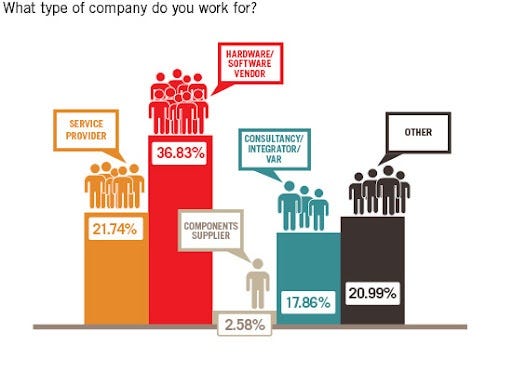
Thirty-three percent hold sales and marketing roles, and 28 percent work in engineering. Others:
Seventeen percent are C-level execs
Four percent work in network operations
Fourteen percent picked "other" for their job function
Our respondents were mobile in another sense, too -- they travel around the world to attend industry conferences and tradeshows. Seventy-one percent of respondents attend one to five events per year, and 9 percent went to more than six events. 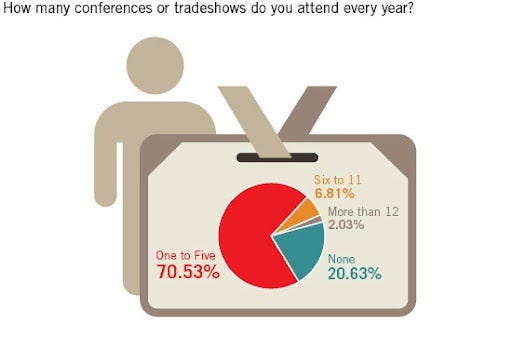
Since most of the survey respondents were based in the U.S., nearly one-fourth currently use AT&T Inc. (NYSE: T), with Verizon Wireless trailing behind at 13 percent.
Other respondents:
Ten percent are T-Mobile US Inc. customers
Nine percent are Vodafone Group plc (NYSE: VOD) customers
Telefónica SA (NYSE: TEF), Sprint Corp. (NYSE: S) and Bharti Airtel Ltd. (Mumbai: BHARTIARTL) each serve about 4 percent of our respondents
China Mobile Ltd. (NYSE: CHL), América Móvil S.A. de C.V. , Salt SA and Telenor Mobil SA each had about 1 percent of the total respondents as customers
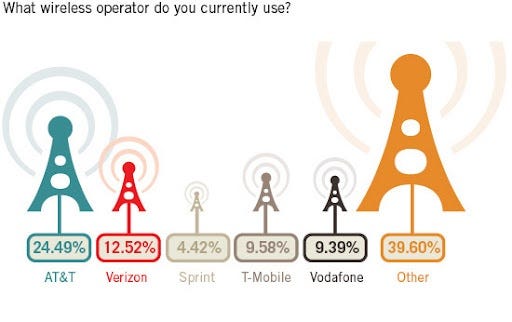
We also asked survey takers what their biggest priorities were when it came to choosing their wireless operator. Most say coverage was the top consideration, beating out both pricing and speed.
Here are some of the highlights:
Thirty-seven percent cite coverage as most important
Twenty-six percent are most concerned with reliability
Twenty-two percent care most about data pricing
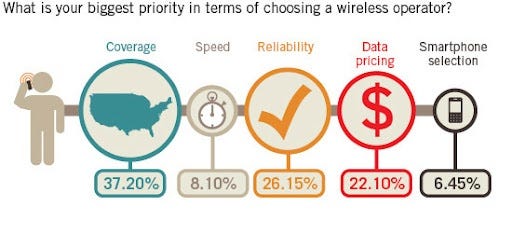
These responses were interesting in light of the different mobile operator marketing messages. Verizon touts its reliability, while AT&T talks up its speed, and Sprint and T-Mobile focus on their pricing value. Our survey would suggest Verizon's messaging is the most spot on, although the carrier has switched tactics somewhat by hyping its 4G LTE speeds. (See Verizon LTE Gets Spoofed, Sprint's Got Some Explaining to Do and AT&T/T-Mobile: The Really Important Question.)
That brings us to the final survey question, How eager are you to change from your current wireless operator? The responses don't indicate people will actually leave, but they show their relative satisfaction with their operators. 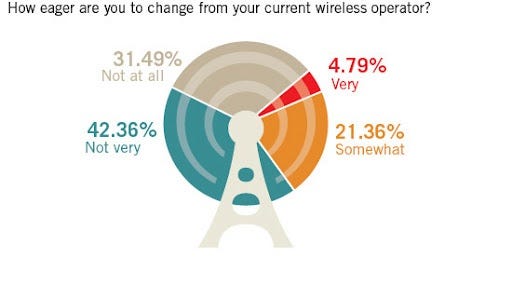
When it comes to smartphones, it's an Apple-versus-Android world right now. Thirty-seven percent of survey respondents said their mobile phone operating system is Apple, while another 34 percent said Android.
For those remaining:
Twelve percent use BlackBerry 's BlackBerry OS
Four percent own a Microsoft Corp. (Nasdaq: MSFT) Windows Phone smartphone, despite the relative newness of the platform
Eleven percent are still hanging on to Symbian phones
Two percent either have an old Palm phone or a newer HP Inc. (NYSE: HPQ) webOS smartphone
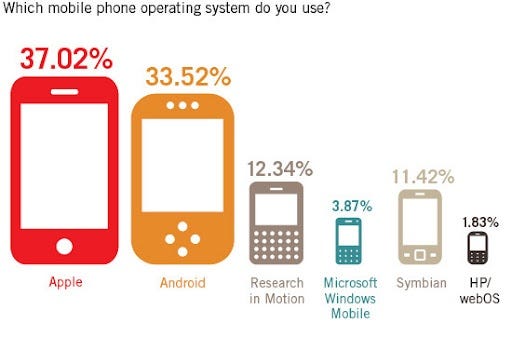
These results reflect the current global OS market share breakdown, although Android and its many smartphones have grown past Apple's one iPhone in recent months. According to Canaccord Capital Corp. 's latest estimates, Android captured 52.7 percent of the overall global smartphone market as of the first quarter of 2012, whereas Apple grabbed 23.7 percent. No other platform came close with RIM at 8 percent, Windows Phone at 7.1 and Symbian at 6.8 percent.
Considering the gap between Apple and Android, we broke down the results to see if a few other commonly held beliefs proved true. Namely, do corporate types still carry a BlackBerry? Are young people Android's biggest user base? And, is Symbian still alive and well primarily in emerging markets like India?
Here's what we found out:
Only 15 percent of respondents in corporate management were using RIM phones. Forty-five percent had iPhones, and another 28 percent used Android smartphones
More than half, 54 percent, of people aged 18 to 28 used Android phones, even beating out Apple, which captured 21 percent of users. Symbian accounted for 17 percent of the youngest category of survey respondents
In India, 30 percent of respondents use Symbian phones, but another 53 percent have Android devices
It's important to note that when we asked about smartphone OSs, we didn't offer an "other" or "none" option. This disqualified a few respondents from answering most of the questions, however, that group of mobile users is growing increasingly slim.
In fact, according to comScore Inc. , more than 100 million Americans now have smartphones. And, with 234 million Americans over the age of 13 using cell phones in January, that puts smartphone penetration in the U.S. at around 43.3 percent. That's just the U.S., however.
Globally, there were 6 billion mobile subscriptions, totaling 87 percent of the world population, at the end of 2011, according to the International Telecommunication Union (ITU) . That's up from just 5.4 billion in 2010.
We did give survey respondents an out on tablet ownership, which proved smart since nearly 50 percent do not own one. Thirty-six percent have iPads. Five percent own a Samsung Corp. Android tablet; 1 percent have the BlackBerry PlayBook; and only two people had an High Tech Computer Corp. (HTC) (Taiwan: 2498) tablet.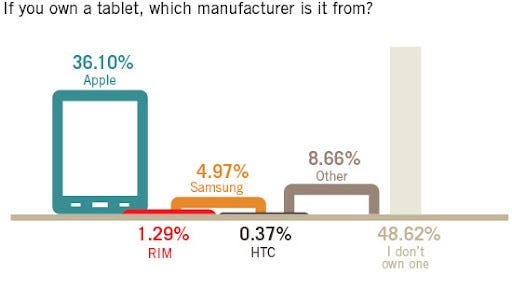
It's increasingly common for households to have multiple people owning multiple mobile devices. To narrow it down, we asked about laptops and ultrabooks, Intel Corp. (Nasdaq: INTC)'s new category of ultra-thin laptops, tablets, and smartphones and cellphones. 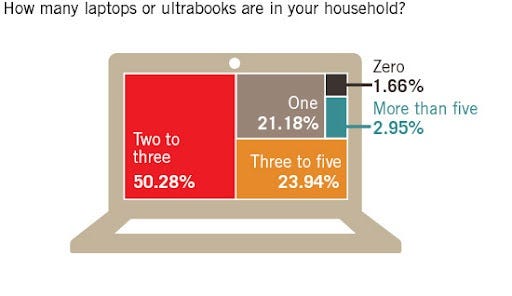
While only half of the survey respondents reported having a tablet, nearly one in five have multiple tablets in their homes. Only one of our survey takers has more than five tablets, but that person's family uses them as laptop replacements with zero laptops or ultrabooks at home. 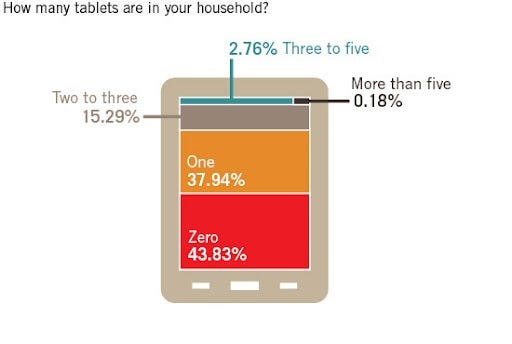
For cellphones, multiple devices in the home are much more common as the average age for children to get their first cellphone continues to decrease. Fifty-two percent of respondents have three to five smartphones or cellphones in the home, and 37 percent have more than three.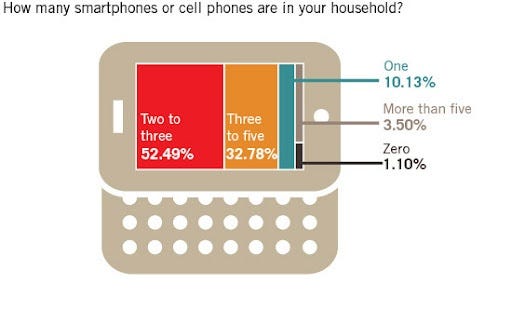
One thing that could make multiple-device ownership more common in the home is shared data plans. Right now, most operators only let users share voice and text minutes amongst multiple devices through a family plan. (See New Data Plans Keep It in the Family .)
However, a number of operators have hinted that they're working on these family data plans, so that could soon change. Infonetics Research Inc. estimates that only 2.4 percent of mobile broadband devices sold globally in 2011 will be on shared data plans, but expects that to grow to 15.4 percent by 2015, so future surveys may show more multiple-device ownership in the home.
If Mobile World Congress was any indication, mobile video chat will be the next great wave of mobile communications. (See Aylus Wants Operators to Get (Video-) Chatty and AT&T Boss Calls for End to Mobile-Video Babel.)
Right now, only a few services that allow users to chat with others within that same service, like fring and Skype, exist. But, no example is more prominent that Apple's FaceTime on the iPhone and iPad.
Twenty-eight percent of survey respondents have at least tried the service. 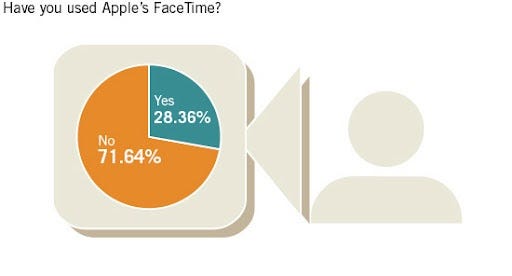
Mark Edwards, CEO of video chat enabler Aylus Networks Inc. , says that 28 percent is in line with what he'd expect. After all, it's not far off Apple's global market share of 23 percent and, chances are, if you have an iPad or iPhone you've at least tried the service. However, he's not convinced many people stick with the service after trying it once.
We didn’t ask survey takers about repeat usage, but among those who own both an iPhone and an iPad, 62 percent have tried FaceTime.
"I think if you have an iPhone, you would've tried it, but if all the people you want to call are using different services -- they may have an Android or BlackBerry -- you will probably abandon the service thereafter," Edwards says.
Smartphones are being positioned as a mobile wallet replacement, but the transition to using the phone for payments and other transactions has been slow moving. One of the biggest roadblocks has traditionally been a lack of consumer interest.
Our survey respondents suggest that's starting to change. While only four survey respondents, less than 1 percent, use their smartphones to make purchases on a daily basis, 15 percent are doing it weekly. Thirty-two percent said they use their phone to make a purchase monthly. 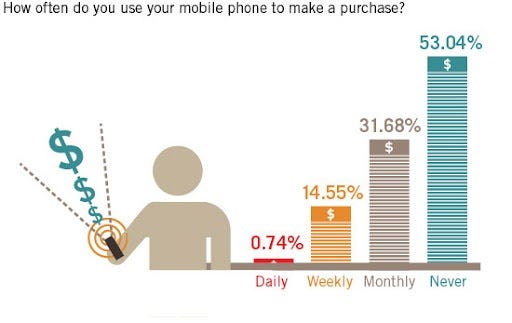
Pyramid Research analyst Emily Smith believes the numbers are impressive. Given that around 43 percent of global consumers are smartphone users, having 47 percent of users who have at least tried mobile payments is exceptional.
"You would think that security would be a bigger concern for users, given that experts have proven how easy it is to crack the security on mobile phones," Smith noted, adding that she too has made one and only one mobile payment in the form of a Groupon Now deal. "The convenience of mobile payments trumped security concerns, even for me."
Mobile payments aren't the only thing that contactless technology in handsets can allow. When we changed the question to include other types of non-purchase mobile transactions, such as redeeming loyalty points, getting a coupon or sharing content with another smartphone, the numbers grew slightly.
For mobile transactions:
Eight percent transact daily
Twenty-one percent do weekly
Twenty-three percent complete a non-purchase transaction on a monthly basis
Forty-eight percent never have
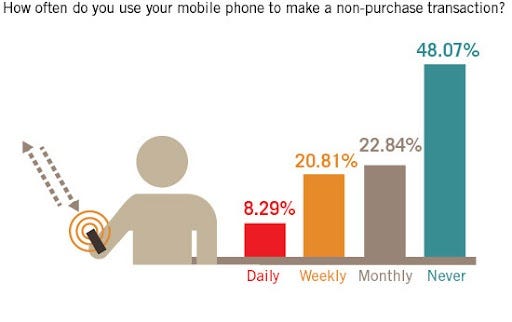
It could be the case that most of our respondents define mobile payments and transactions as something they do on the device, and not necessarily using the device as tap-to-pay credit card replacement. One reason that has been slower to take off is the lack of Near-Field Communications (NFC) chips in many smartphones today.
A few Android phones have NFC chips on board, including the Samsung Nexus S, which supports the mobile transaction service Google Wallet. Even so, 57 percent of Android users have never used their phone to make a purchase, suggesting awareness -- or interest -- still has room to grow.
Mobile video is the No. 1 killer app when it comes to mobile content. It's the reason wireless operators are spending billions to beef up their networks and why LTE networks hold so much appeal both to operators and data-hungry consumers.
So, were our survey respondents part of the video-mongering majority? They weren't daily users, but, notably, nearly all iPhone users were. Overall, of the 66 percent that watch video, 43 percent watch it weekly, and 40 percent do monthly. For iPhone owners, 15 percent watched daily, and 36 percent watched weekly.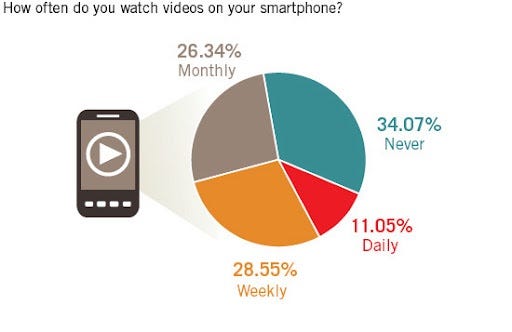
Tablets provide a bigger, higher-resolution screen for video viewing. And, indeed, our survey respondents spent more time watching here. Amongst the 55 percent that own a tablet:
Thirty percent watch videos daily
Forty-five percent do weekly
Fifteen percent watch videos on a tablet monthly
Surprisingly, 10 percent of tablet owners have never watched a video on their device
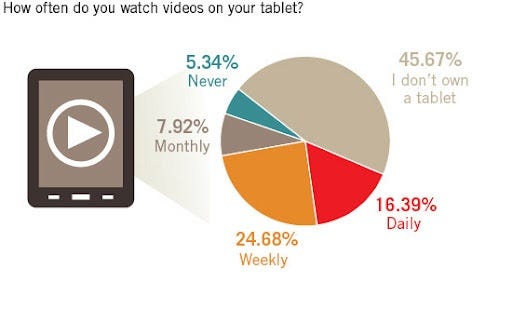
With 585,000 mobile apps in the iPhone App Store alone, finding apps to download isn't a challenge. But, finding quality apps that you'll use on a regular basis can still be challenging. And, while Apple says it has crossed the 25 billion download mark, downloads don't always translate into usage.
While only 1 percent claimed to use more than 30 apps regularly, the majority use a good handful of apps on a regular basis -- defined as at least once a week. 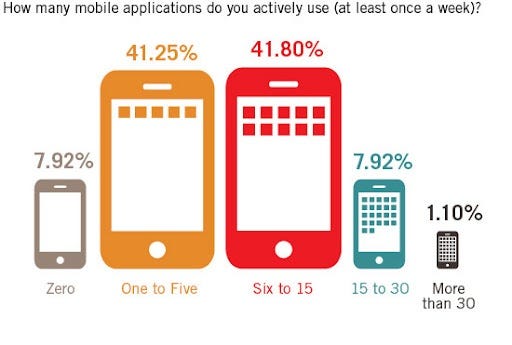
According to research from mobile apps analytics company flurry Inc. , 38 percent of apps downloaded are used again within a month, based on a sample of 10 billion downloads on iOS and Android. Flurry VP of Marketing Peter Farago says that after six months, 14 percent of consumers who downloaded and used an app at least once use that app again.
Social networks remain amongst the top mobile apps, and about half of our survey respondents maintain an active presence on Facebook , LinkedIn Corp. , Twitter Inc. or Google+. Of the 47 percent of respondents who update their statuses on at least one of the aforementioned social networks:
Sixty-three percent update their status once a day
Thirty-five percent update two to five times per day
Five percent do it five to 10 times per day
Only 2 percent inundate their online friends with status updates more than 10 times per day
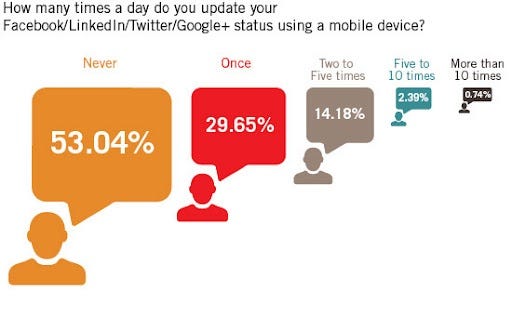
One social-networking segment that stood out was those over 40 years of age, which included 72 percent of our survey takers. Forty-two percent said they update their status at least once a day, a figure striking enough to catch the eye of Pyramid Research Mobile Analyst Stela Bokun.
"I’d expect that the crowd of that average age, even if they are as tech savvy as [telecom professionals] would not be such intense users of social networking at all, let alone mobile social networking," Bokun says.
Mobile data is on the rise, as you'd expect. Nearly half of our respondents use between 201MB and 1GB of data per month. Thirty-four percent use more than that. Looking at tablet owners alone, the number grows to 45 percent using more than 1GB per month.
When you consider that 65 percent of people reported using Wi-Fi whenever they can, the data numbers -- that 34 percent are using more than 1GB of data per month -- start to look even higher. 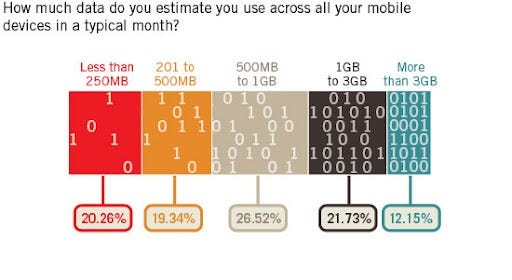
From a consumer point of view, the concern with mobile data usage is, of course, hitting the data cap. Most wireless operators have already instituted tiered data pricing, in which fees or throttling kick in once a certain cap is reached. For our survey takers, a full three-fourths were able to avoid hitting their monthly limit because they are still on an unlimited plan (42 percent), they don't use enough data (25 percent) or they don't have a data plan (8 percent). The rest say they haven't been as lucky.
Five percent hit their cap every single month
Eight percent hit it every couple of months
Six percent estimate they reach it once a year
Five percent say only once as they've been more cautious since then
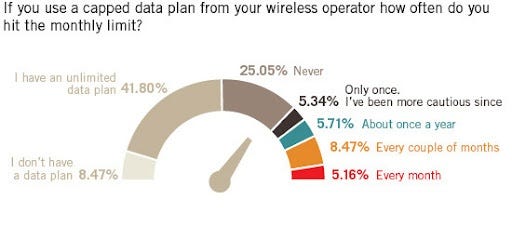
Mobile data isn't cheap. In fact, 20 percent of survey respondents pay more than $151 for data across their devices. What's more, 32 percent of those forking over that much are only paying one service plan, which speaks to how expensive plans have become.
Paying only one service plan, most likely a smartphone bill, was the norm for 49 percent of our survey respondents. Another 41 percent said they pay two to three plans, and 20 percent of that group ends up paying $151 or more per month.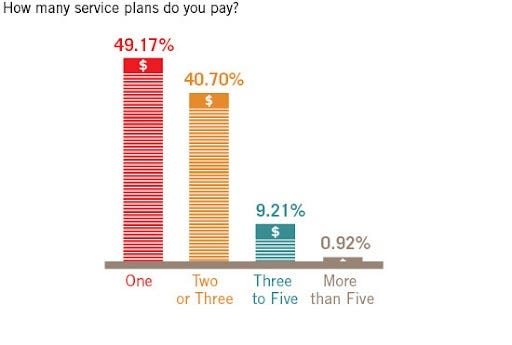
Fifty-six percent of the survey respondents say they are still paying less than $100 for data, while 34 percent fall in the $100 to $200 range, and 10 percent crack $200.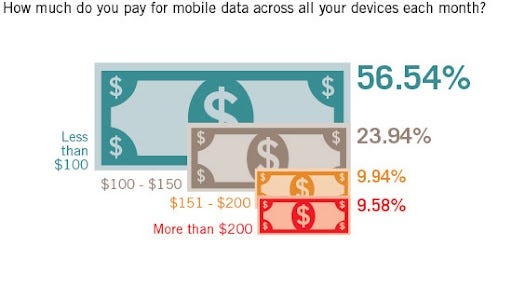
One increasingly common way users are saving on data costs -- or at least avoiding overages -- is by using Wi-Fi networks wherever possible. The operators are embracing Wi-Fi offload as a strategy for relieving data congestion, as well.
According to Thomas Barnett, Cisco's senior manager of service provider marketing, 11 percent of mobile data traffic is currently being offloaded to Wi-Fi, a number Cisco sees growing to 22 percent by 2016. That number rises to 60 percent globally when just looking at tablets today.
"We see Wi-Fi as a clear and important strategy for wireless operators," Barnett says. "We looked at hot spots and homes, and a lot of mobile traffic is not on the move, but where we happen to be."
Well, that wasn't quite the case with our survey respondents. Sixty-six percent said they use mobile data the most while on the go, compared to just 23 percent who said at home. When asked how often they substitute Wi-Fi for cellular data, however, 65 percent whenever possible, and 24 percent said only when they're at home. 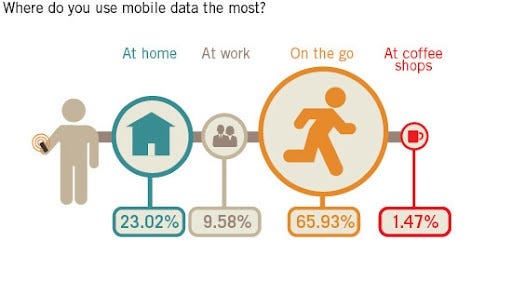
Notably, 2 percent said they didn't know when their devices were using Wi-Fi versus cellular data. The remainder either used Wi-Fi only as a strategy to avoid their data cap or never bothered using it at all. Of the 7 percent who said they never use Wi-Fi, but they have a data plan, 21 percent have hit their cap before. Forty-one percent still have unlimited plans. 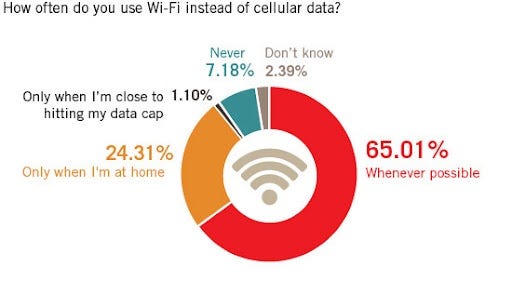
AT&T has been the most aggressive with Wi-Fi offload and currently offers access to more than 190,000 hot spots globally through roaming agreements. The carrier said that 1.2 billion Wi-Fi connections were made off its network in 2011, with 486.9 million occurring in the fourth quarter alone.
Of our respondents that were also AT&T customers, 71 percent said they make use of its Wi-Fi network whenever possible. Forty-seven percent of them were grandfathered in to unlimited plans.
While nearly all the operators across the globe have plans to move to LTE, their customers don't yet share those same plans. Interest in LTE was pretty low amongst our survey respondents. Seventy-eight percent don't own any LTE devices, and 68 percent don't plan to purchase any in 2012.
Interestingly, the one category that saw a significant uptick between current ownership and plans to buy in 2012 was tablets. Only 3 percent of people currently own an LTE tablet, but 15 percent plan to buy one this year. No doubt, many of those purchasers will likely gravitate toward Apple's new LTE iPad, launched in March. (See Apple Intros First 4G LTE iPad.)
There was only a 4 percent uptick, from 16 percent to 20 percent, in those who planned to purchase an LTE smartphone. 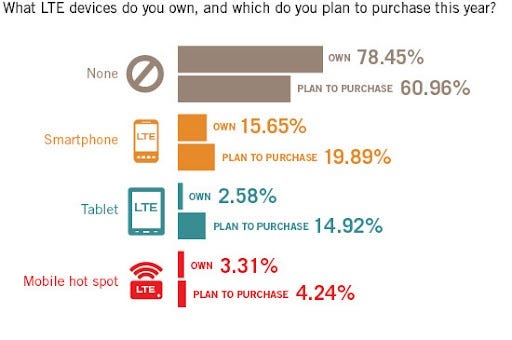
Verizon Wireless is currently the furthest along with LTE as it covers 178 markets and 200 million POPs at press time. Its customers were split more evenly when it came to LTE device ownership. Fifty-four percent said they don't currently own one, and 44 percent said they have no plans to buy one. But for those who do own LTE devices, 12 percent own a mobile hot spot and 29 percent own a smartphone. Tablets still have the most room for growth, with only 4 percent currently owning one and 26 percent planning to purchase one this year.
"Once the selection of LTE devices offered by other operators improves, [the] LTE numbers should be much higher at least in the U.S.," Pyramid's Bokun says.
Back to the start of Light Reading's 2012 Mobile Life Survey.
— Sarah Reedy, Senior Reporter, Light Reading Mobile
About the Author(s)
You May Also Like












